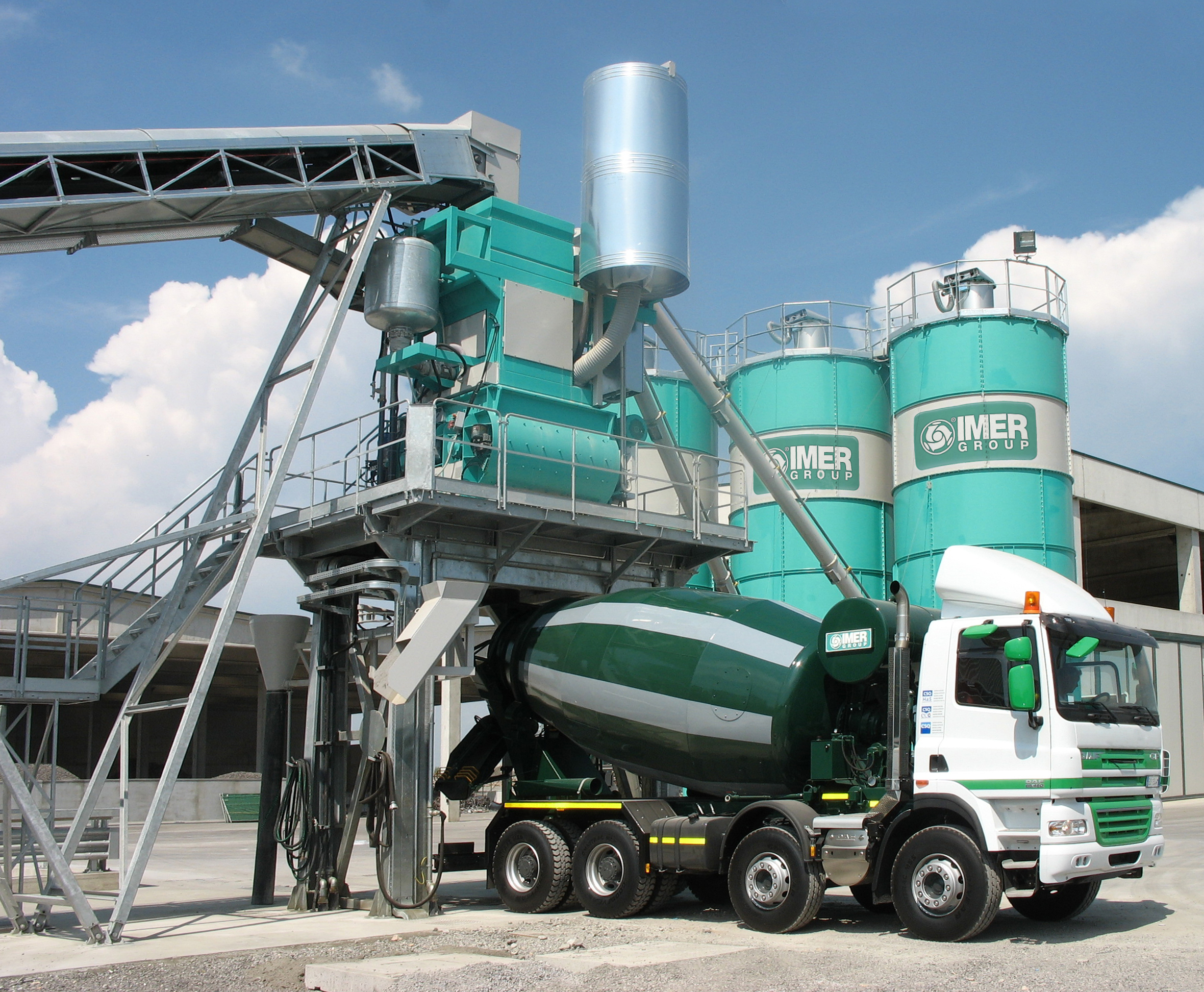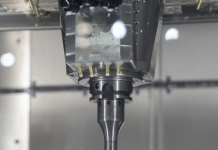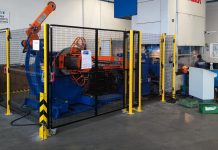Perhaps not all know that in the batching sector, i.e. the manufacturing ambit concerning the activities of concrete preparation for civil constructions, prefabrication and structural works, operate top-level companies that develop and manufacture forefront machinery and plants. Chip removal machining constitute also in this case the “technological base” of manufacturing processes to obtain high-quality machinery. For this reason, our review has decided to deepen the knowledge of ORU – Le Officine Riunite Udine S.p.A., international reference company in the development of solutions for the production, the transport and the laying of concrete. Horizontal twin-shaft mixers, both for fixed and mobile plants, constitute an excellence in the production by Officine Riunite Udine: «We offer the market – specifies Perego – two product families intended for mixing, the planetary pan mixers ORU MS and the horizontal twin-shaft mixers ORU MD». ORU MS are planetary pan mixers with vertical shafts and coaxial motor; they are a historical product for the Friuli brand and represent the most complete solution in the mixing ambit. The line of ORU MD mixers with horizontal twin-shaft has been instead developed more recently and we are going to analyse thoroughly this product typology.
Refined and complex design
«The main idea – explains Giacomo Perego – consisted in manufacturing a family of horizontal twin-shaft mixers standing out for high efficiency and long service life in time, able to grant concrete production of excellent quality». To reach this result, the technicians of the Friuli company have deployed their experience in the mixing ambit, in addition to forefront calculation and analysis software. Perego: « The parameters that influence the mixing yield are several. The most important are the shape and the size of the mixing pan, the number, the position and the design of mixing blades, and the ratio between the volume of the pan and the volume of the mixed material». To reach the best possible configuration, i.e. the best definition of such geometrical parameters, the engineers of ORU have carried out several simulations through ANSYS software, afterwards followed by a prototyping and testing phase for the validation and development of theoretical results. «It was not trivial to design a machinery able to mix in few seconds over 10 tons of material and able to achieve finished concrete of the highest quality and homogeneity, compliant with the most severe and strictest requisites of the European regulations and directives, and not only, on the matter», specifies Perego. Side by side with that research process of the best parameters for the concrete production, ORU technicians proceeded to carry out finite element mechanical simulations through the CAD Solid Edge and the abrasion caused by inert materials (sand, gravel, grits and so on) contained inside the mixture. «Depending on the inert type and their origin, alluvial or by crushing – further adds the marketing manager –, varies the type of wear of shafts and of mixing blades and it is therefore very important not only to size such members correctly but also to use special high strength steels and anti-wear armours». Moreover, another important aspect was making “economically sustainable” choices, since we have always assessed the costs of concrete manufacturing and plant management (optimized motor powers and consumptions), so that the machinery, besides granting the highest concrete quality, assured high operation performances, long service life, low consumptions and maintenance costs at competitive purchase prices to users. After several months of design, analysis, trials and laboratory tests, the design of the ORU MD line was “ended”. Perego: «Our efforts have been awarded. We have succeeded in designing a very sturdy mixer, resistant to wear, with highly reliable sealing systems and especially able to produce concrete of excellent quality, faithfully reproducing the mixing “recipes” formulated by our management software».
“Made in Friuli” production
The manufacturing of the MD range, as well as the design, is almost completely accomplished inside the production plants of ORU at Basaldella di Campoformido, in Udine province. The manufacturing cycle provides for the machining of semi-finished steel products through plasma cutting operations, robotic welding and stock removal on machine tools. Moreover, the heat treatment phases by external suppliers are provided, besides painting, assembling and finally testing. Perego: «The only components purchased abroad are the electric motors and the reduction units. We instead manufacture in-house the elements that represent the core itself of our mixers: the pan, the shafts, the mixing blades and the “lanterne”, i.e. the metal containers inside of which are housed the sealing systems and the bearing seats for the shaft rotation». The pan, i.e. the big container where the mixing occurs, is obtained by laser or plasma cutting of raw structural sheet steels; such sheet steels are bent and finally welded through apposite “templates”. The production is carried out according to a “Kanban”-type intelligent logic, which allows the production of the necessary components with a “one piece flow”. Once assembled, the pan is moved on large boring machines, with magazines ranging from 40 to 90 tools, where milling and boring operations are performed. Perego: «We machine by stock removal the pan when it is already assembled and not previously the single elements composing it, even if it is more expensive in terms of costs, to attain the highest precision, in particular to obtain the perfect alignment of the holes inside which bearings and the sealing system of mixing members will be housed. Likewise we machine the seats of motors, reduction units and “lanterne”». On the other hand, if the alignment is more precise the rotation is smoother, minor are the member wears and longer is the service life of the entire machinery. Besides the pan, the mixing shafts and blades are produced. The shafts are just two arms with square section, i.e. two long parallelepipeds of hardened steel, obtained by means of milling and turning of a forged part; in one of the extremities is obtained a grooved profile for the coupling with the reduction unit. Such machining processes are carried out on lathes, milling and gear cutting machines and the entire shaft execution cycle lasts 7 hours on average. Perego: «The perfect rotation of such axes, which weigh even 400 kg and are more than three metre long, and must rotate starting from 30 rpm, is granted only by the compliance with very strict tolerances, in the order of hundredths of millimetre». Along the shafts are fixed the arms, at whose extremities are then fastened the blades, i.e. the elements that, thanks to their shape, carry out the real mixing. «The blades, whose design is one of the elements that more influence the mixing quality, as said before, are made of high-strength steel and then mechanically machined or, depending on the configurations, of chromium iron casting, finished by heat treatment». Once fixed shafts, arms and blades, the whole is then protected by the finishing and painting process. The heat treatments of the various parts are indispensable for machines of this kind, in order to grant long durability and an adequate answer to the various stresses; without these differentiated treatment phases, probably in few weeks of work the mixer would need relevant interventions. Other components obtained by stock removal are “lanterne”: Perego: «They are box-shaped elements made of cast iron, apt for containing the sealing systems and the bearings of rotation shafts. Castings are then finished by machining on multi-spindle lathes with a cycle time of 8 hours».
Assembling and testing
Once manufactured the pan, the shafts, the blades and the “lanterne”, the assembling starts. Perego: «In all the departments of our factory we apply the principles of the “lean production”, philosophy that aims at minimizing wastes up to annulling them». This happens also in the assembling department, where are transported all components, both those manufactured in-house and those purchased abroad, codified and pre-tested. «Assembling operations, including welding, are executed in compliance with the most severe regulations, take place in fast and rational manner and last a couple of days on average», specifies the marketing manager. All mixing members are painted and mounted inside the pan, with related motors, reduction units, sealing systems and no-wear coatings. The mixer is so ready for the final testing. The manufacturing cycle ends with the most sensitive parts that might oxidize during the transport to the yard, with the delivery to the plant assembling or packaging division. Giacomo Perego ends: «The target of widening the range of our plant was perfectly hit. The market has welcomed our proposal very favourably, to the extent that in a short time the percentage of customers demanding horizontal twin-shaft mixers has grown from 15 to 50%».










